

 Anthropozoologica
51 (2) - Pages 149-171
Anthropozoologica
51 (2) - Pages 149-171Analyses of the Neolithic and Chalcolithic industry in hard animal material from the western Mediterranean include a rich corpus of studies focusing on osseous industries. However, studies relating to the shell industry mainly concentrate on the production of ornamental objects, and the overall background of this raw material for the production of utensils used for transformation activities is not yet well known. The technological analysis of the hard animal industry of Cuccuru S’Arriu (Cabras, Sardinia) discovered in Final Neolithic structures (4000-3500 BC) led to the identification of many sea shells collected for making artefacts, ornamental objects and utensils. This article focuses on the morpho-technological analysis of the Glycymeris da Costa, 1778 shells used as utensils, and the identification of artefact function. In particular, the experimental activities carried out for the analysis of use-wear traces are presented. These activities enhance our understanding of artefact functions (smoothers, scrapers or small containers). Finally, this study allows us to assess the important role of this industry in the production activities of Final Neolithic societies in Sardinia and reveals previously unknown data regarding the reconstruction of the ways of life of insular prehistoric societies. It is currently one of the few Neolithic samples in the western Mediterranean.
Shell industry, use-wear traces, Final Neolithic, Cuccuru S’Arriu, Sardinia